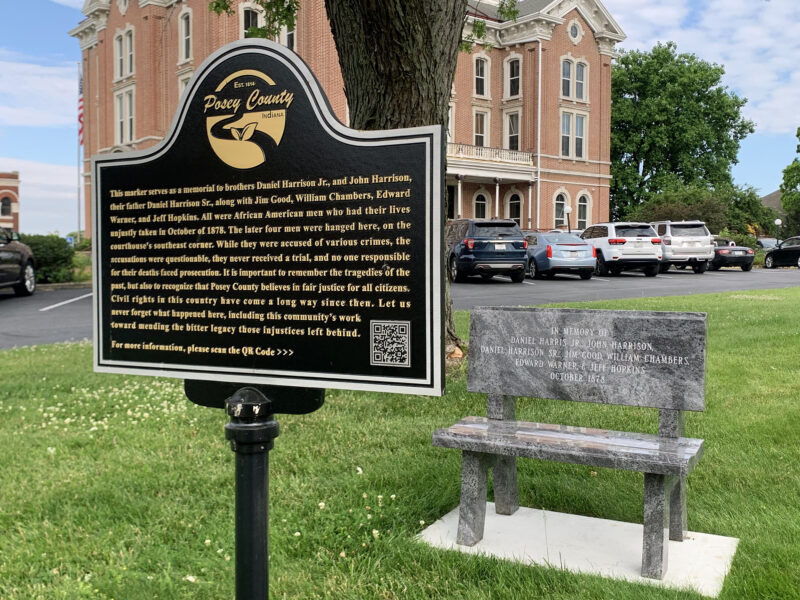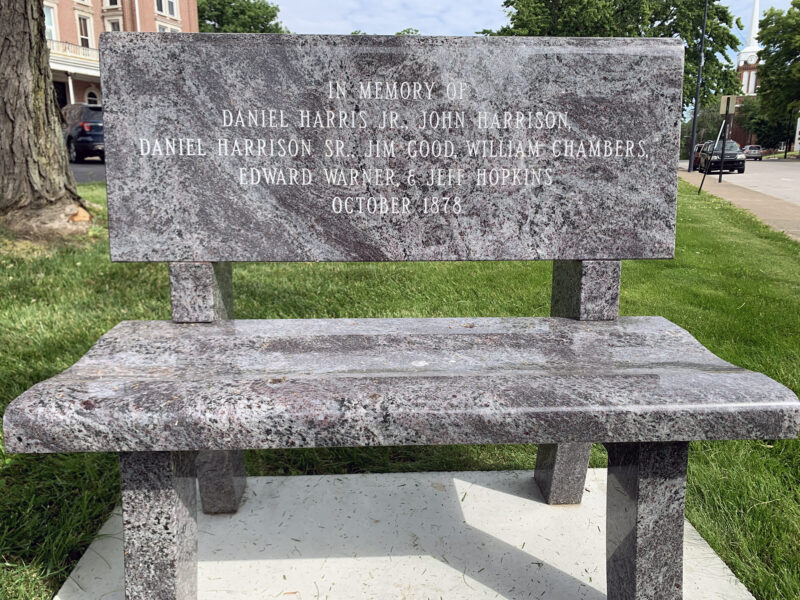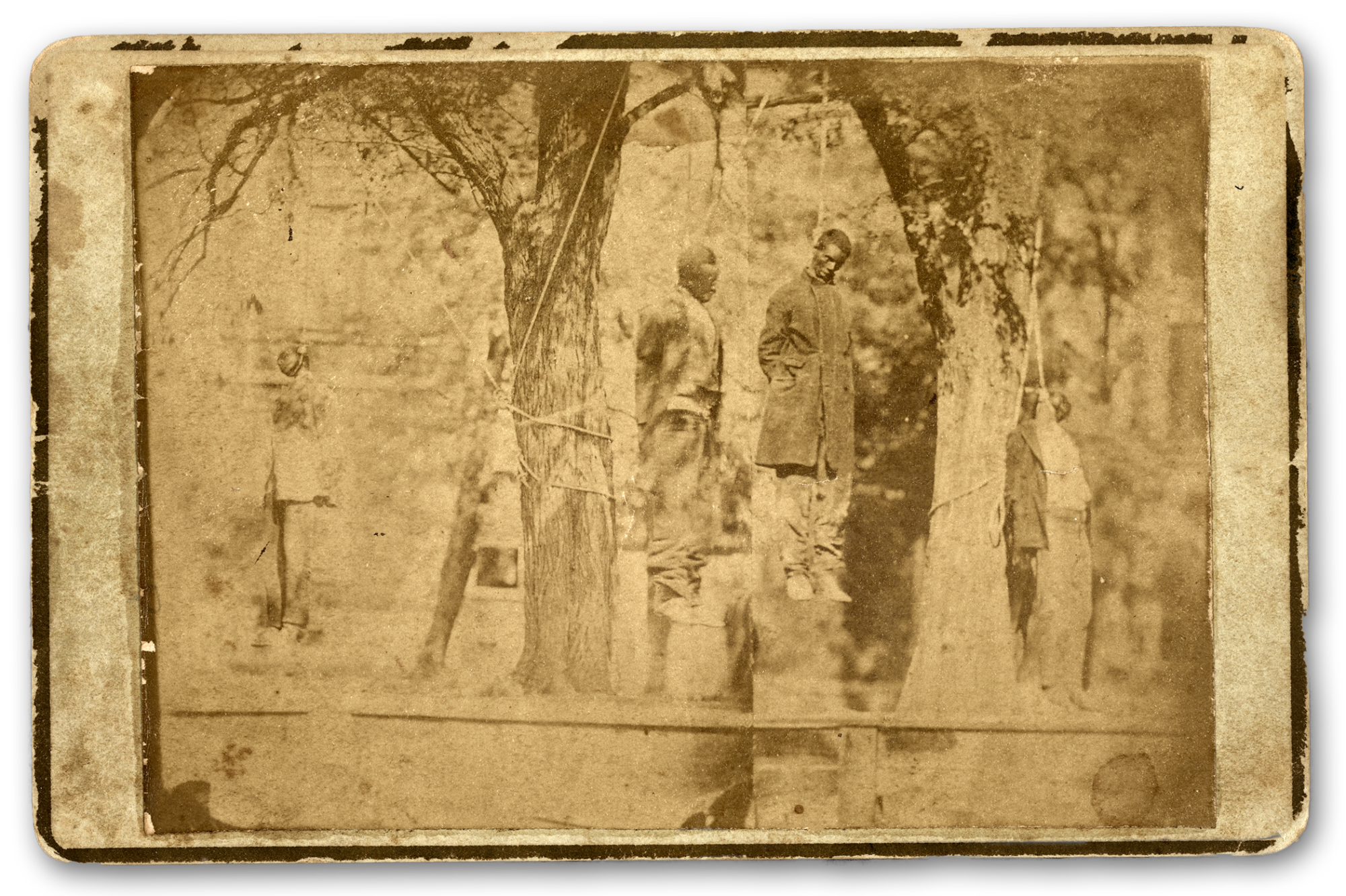Finding Myself Inspired by a Modern Day Teenage Activist
Share
Breaking News!
Today's news and culture by Black and other reporters in the Black and mainstream media.
Ways to Support ABHM?
Scholar-Griot: Samantha Humes, Attorney at Law
In 2022 I found myself inspired after watching a story featured on CBS Sunday Morning called “It’s Unacceptable to Just Forget.” It highlights a small southwestern Indiana town and a remarkable high school student named Sophie Kloppenburg. I invite you to pause here and watch the same video clip I did in 2022.
Sophie Kloppenburg’s story is modern day activism come to life. It’s her deciding that after 144 years of silent indifference, seven African American men lynched in October 1878 would officially be recognized with a memorial bench and sign in Mt. Vernon, Indiana. Let us all know their names – Daniel Harrison, Sr., Daniel Harrison, Jr., John Harrison, Jim Good, William Chambers, Edward Warner, and Jeff Hopkins.
I was moved by Sophie’s need to address these injustices, her hard work, and her perseverance. I was likewise inspired by a small town’s willingness to publicly acknowledge and condemn violent and racist events in its history. Her efforts garnered the attention of both national and local media, and it galvanized her local community. I began to take a closer look at the events of this tragic story, and ultimately visited Mt. Vernon, Indiana myself in May 2023.
The Posey County Courthouse that exists today in Mt. Vernon is the same one that stood when these events took place in 1878. The courthouse had been completed just two years earlier in 1876. Visiting Mt. Vernon in May 2023 was like being transported back in time. Thanks to Sophie Kloppenburg and her supporters, a memorial bench and sign concerning these events was placed on the courthouse’s grounds and recognized in a public ceremony on October 23, 2022. The sign possesses a QR code allowing visitors unaware of the history to learn more. The QR code takes the visitor to an informational website maintained through the David L. Rice Library at the University of Southern Indiana which can be found here:
Trigger Warning: Please note that this exhibit does contain graphic images and descriptions. As a result, some may find the content not suitable. Unfortunately, history contains some truths that can be violent and traumatic. Keep this in mind before you read further. The ultimate goal is to educate on difficult topics in a thoughtful manner, not cause unintended distress to any particular reader.
Here are photos showing the memorial bench and sign, as well as the historic courthouse, as they stood at the time of my visit on May 30, 2023.



Unfortunately, many details of the events of October 1878 appear lost to history. James M. Redwine, a resident and prior serving judge for Posey County, has written an informative book called “Judge Lynch!” about the tragic incidents. While rooted in many of the known facts about what occurred, it is ultimately a book of historical fiction.
The QR Code provides the visitor with the pertinent known facts. The killing of these seven men marked the largest recorded lynching of African Americans in Indiana’s history. All seven men were lynched within a few days of each other between October 10-12, 1878, by white citizens of Posey County, Indiana. Sadly, but not surprisingly, while a grand jury was later convened to investigate, no person was ever prosecuted for the murder of these men. Looking back through the historical lens of racism, these men fell victim to the vilest ills of society and the justice system of the time period.
Jeff Hopkins, Edward Warner, William Chambers and Jim Good had been under arrest and in custody at the county jail on allegations of having raped white prostitutes. On October 12, 1878, a large white mob forcibly removed the four men from the jail. The mob proceeded to execute the four men by hanging on the grounds of the Posey County Courthouse in Mt. Vernon, Indiana.
Daniel Harrison, Jr., John Harrison, and Daniel Harrison, Sr. were killed separately by white vigilantes between October 10-12. These three men were related – Daniel Harrison, Sr. was the father of Daniel Jr. and John Harrison. Daniel Harrison, Jr. was gruesomely murdered by being burned to death inside the fire box of a steam locomotive. John Harrison was shot to death and his body stuffed inside a tree. Daniel Harrison, Sr. was accused of having harbored his two sons, John and Daniel, Jr., by the authorities. When arresting Daniel Harrison, Sr. for this alleged offense, Harrison, Sr. shot and killed a deputy. Daniel Harrison, Sr. was soon after violently murdered by a white mob and his remains humiliatingly placed in the jailhouse privy.
None of these men were afforded any due process or trial on any allegations they faced.
A photo of what is believed to be the lynching of Jeff Hopkins, Edward Warner, William Chambers and Jim Good on the grounds of the courthouse exists in the archives of the Rose Library at Emory University. A link to this same photo is included on the information website that can be accessed by the memorial sign’s QR Code.
An enhanced image of the photo can be viewed below. Please be advised that the image is graphic.

The original image was acquired from Rose Library, Emory University and enhanced here for better viewing. It is part of the library’s Robert Langmuir African American photograph collection. The photo was purchased by Emory University in 2012 from Robert Langmuir, a private collector and rare book dealer in Philadelphia, PA.
One valuable tool to better understand white public sentiment during these events in 1878 is newspaper accounts. I viewed several newspaper stories pulled from local and nearby communities to assess how these events were reported on by the white community in 1878.
I provide two articles here for viewing that are illustrative of the blatant racism and sheer level of violence that was perpetrated on these men. The articles appeared in the Evansville Daily Courier on October 12, 1878 and the Fort Wayne Sentinel on October 14, 1878. Each one is provided in full for review and reflection.
Every sentence of the reporting is bursting with racist ideology and a desensitization to violence. Examples literary mark each turn of phrase. The reportings are also informative about public sentiment about vigilante behavior. The Evansville account has the disturbing banner title of “Judge Lynch Holds Court and Passes Summary Sentence” on prominent display. Terms such as “brutes,” “bestial villains,” and “villainous-looking” were used to describe the African American men. Racists tropes with an article subheading that read “Their Wives Were Not Safe,” meaning the white wives of the white men of the town, were used. Conversely, the white deputy shot and killed by Daniel Harrison, Sr. was described as “highly respected” and a “faithful officer.”
The level of violence was so descriptively detailed. If such articles are proof, the public appears to have had an easy appetite for salacious accounts without thought to the human loss. It was said that Daniel Harrison, Sr. “In five minutes his body was cut into pieces like a hog, head, arms, legs, all separated, and the sickening mass of human flesh was flung into the privy.” Additionally, there is reference to the men declaring their innocence and Mr. Harrison, Sr. believing his life was threatened when he shot and killed the deputy. However, sentiment was quite clear in the reporting – a sound belief in the overwhelming guilt of the men. And a belief that what occurred was justified. The Fort Wayne article boldly notes, “The members of the mob are, of course known, but it is safe to say that they will never be punished.”
The events that took place in Posey County, Indiana in 1878 were simply horrific. Yet, I do believe there is a lesson in all this tragedy. And it is a lesson of hope. It is the power of a single person, a single voice, that is joined by others so that history is not forgotten. We must uncover the truths of our history, however painful.
Mt. Vernon, Indiana is like so many small towns across America. I wonder about all the other untold stories that might still be waiting to be unearthed and have a bright light shined upon them. I realized that each place often has a collection of caretakers or storytellers for that place. Like my experience meeting historian Ray Kessler and Jane Saltzman at the Posey County Historical Society. There is work going on every day in every community to safeguard history for future generations. All we need to do is have a curious heart and go exploring.
I began this piece speaking of how inspired I was by a remarkable teenage activist. But I ask myself, is being inspired enough? I may be wrong, but I think Ms. Kloppenburg’s answer would be “no, it is not enough.” She did more than inspire a feeling or an emotion, she inspired action. She got something accomplished that was likely not before thought possible. I want to learn from her example. So, my job now is to figure out how I might be a person of positive action or change. I have had a 20+ career as a criminal defense attorney in Wisconsin. And social justice issues have always been important to me. So perhaps I don’t have too far to search for my next call to action. Maybe each of us can use our own special and individualized gifts to effectuate positive change in our community. And if Sophie has taught us anything, we don’t have to do it alone – for together we can seemingly do anything.
But, in the meantime, I simply want to say “Thank you, Sophie Kloppenburg, for a job well done.” You reminded us all that it is unacceptable to just forget.
- To learn about Sophie Kloppenburg’s newest ongoing efforts to both acknowledge and repair the legacy of racial harm in our country, click to view “One Year Later Sophie Kloppenburg Continues to Inspire.”
Samantha Humes is a graduate of Indiana University and the University of Wisconsin Law School. She has specialized in criminal defense for 20+ years, mostly representing the indigent. She most recently has expanded into immigration and Afghan asylum work. She calls Wisconsin home.









Comments Are Welcome
Note: We moderate submissions in order to create a space for meaningful dialogue, a space where museum visitors – adults and youth –– can exchange informed, thoughtful, and relevant comments that add value to our exhibits.
Racial slurs, personal attacks, obscenity, profanity, and SHOUTING do not meet the above standard. Such comments are posted in the exhibit Hateful Speech. Commercial promotions, impersonations, and incoherent comments likewise fail to meet our goals, so will not be posted. Submissions longer than 120 words will be shortened.
See our full Comments Policy here.